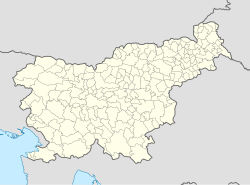Kolovec
Kolovec | |
|---|---|
 | |
| Coordinates: 46°11′39.9″N 14°38′28.48″E / 46.194417°N 14.6412444°E | |
| Country | |
| Traditional region | Upper Carniola |
| Statistical region | Central Slovenia |
| Municipality | Domžale |
| Area | |
• Total | 5.61 km2 (2.17 sq mi) |
| Elevation | 388.4 m (1,274.3 ft) |
| Population (2020) | |
• Total | 58 |
| • Density | 10/km2 (27/sq mi) |
| [1] | |
Kolovec (pronounced [ˈkoːlɔʋəts]; German: Gerlachstein[2]) is a settlement northeast of Domžale in the Upper Carniola region of Slovenia.[3]
History

The Kolovec area was settled in Roman times, as attested by the discovery of artifacts there. Until the 19th century, bandits were active in the area; the Paleževina farm was owned by a bandit chief named Groga circa 1810, and the Čeh farm northwest of the village center was portrayed in Josip Jurčič's novel Rokovnjači (The Bandits) as the Mozolovina farm. During the Second World War, the Partisans stored food and weapons in the forest near Kolovec.[4]
Castles
Kolovec was the site of two castles in the past. Both are mentioned and depicted by Johann Weikhard von Valvasor in his The Glory of the Duchy of Carniola as Gerlachstein.
Old Gerlachstein Castle
Old Gerlachstein Castle, also known as Kolovec Castle (Slovene: Kolovški grad), stood on a hill northeast of the settlement and was built in the 12th century.[4] It burned down in 1560, and the site was abandoned. Today it is referred to in Slovene as Stari grad 'the old castle'. The ruins of the castle are still visible.[5]
New Gerlachstein Castle
The second castle, built just outside the settlement to the southwest, was built in 1530. It burned down in 1679, but was rebuilt by the owners. During the Second World War it was used by the German army as its local headquarters until 1942, and it was burned down by Partisans in April 1943, supposedly to prevent the army from using it again. The remains are barely visible today.[6]
Notable people
Notable people that were born or lived in Kolovec include:
References
- ^ Statistical Office of the Republic of Slovenia Archived November 18, 2008, at the Wayback Machine
- ^ Leksikon občin kraljestev in dežel zastopanih v državnem zboru, vol. 6: Kranjsko. 1906. Vienna: C. Kr. Dvorna in Državna Tiskarna, p. 23.
- ^ Domžale municipal site
- ^ a b c Savnik, Roman (1971). Krajevni leksikon Slovenije, vol. 2. Ljubljana: Državna založba Slovenije. p. 90.
- ^ Kolovec I on Castles in Slovenia site (in Slovene)
- ^ Kolovec II on Castles in Slovenia site (in Slovene)
- ^ Dimitz, August (1876). Geschichte Krains von der ältesten Zeit bis auf das Jahr 1813. Ljubljana: Kleinmayr & Bamberg. p. 113.
- ^ "Hohenwart, Franc Erazem, pl. (1650–1714)". Slovenska biografija. Retrieved March 3, 2022.
External links
 Media related to Kolovec at Wikimedia Commons
Media related to Kolovec at Wikimedia Commons- Kolovec on Geopedia






